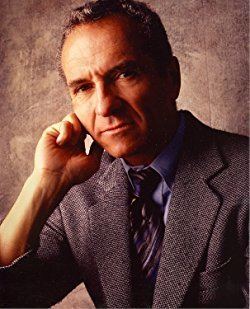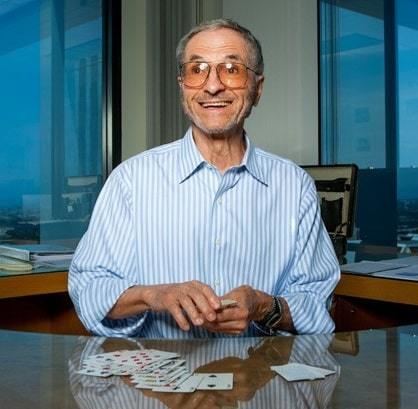Residence United States Name Edward Thorp Citizenship American Role Professor of mathematics | Alma mater UCLA Doctoral advisor Angus E. Taylor | |
 | ||
Born August 14, 1932 (age 93) Chicago, Illinois, U.S. ( 1932-08-14 ) Thesis Compact Linear Operators in Normed Spaces (1958) Books Beat the dealer, Beat the Market: A Scientific Stock Market System, The mathematics of gambling, Elementary Probability Similar People Claude Shannon, Angus Ellis Taylor, Vannevar Bush, George Boole | ||
Edward o thorp
Edward Oakley "Ed" Thorp (born August 14, 1932) is an American mathematics professor, author, hedge fund manager, and blackjack player. He pioneered the modern applications of probability theory, including the harnessing of very small correlations for reliable financial gain.
Contents
- Edward o thorp
- BJ Optimum Strategy Edward O Thorpe UCLA
- Computer aided research in blackjack
- Applied research in Reno Lake Tahoe and Las Vegas
- Stock market
- References

He is the author of Beat the Dealer, the first book to mathematically prove, in 1962, that the house advantage in blackjack could be overcome by card counting. He also developed and applied effective hedge fund techniques in the financial markets, and collaborated with Claude Shannon in creating the first wearable computer.

Thorp received his Ph.D. in mathematics from the University of California, Los Angeles in 1958, and worked at the Massachusetts Institute of Technology (MIT) from 1959 to 1961. He was a professor of mathematics from 1961 to 1965 at New Mexico State University, and then joined the University of California, Irvine where he was a professor of mathematics from 1965 to 1977 and a professor of mathematics and finance from 1977 to 1982.
BJ Optimum Strategy: Edward O Thorpe, UCLA
Computer-aided research in blackjack
Thorp used the IBM 704 as a research tool in order to investigate the probabilities of winning while developing his blackjack game theory, which was based on the Kelly criterion, which he learned about from the 1956 paper by Kelly. He learned Fortran in order to program the equations needed for his theoretical research model on the probabilities of winning at blackjack. Thorp analyzed the game of blackjack to a great extent this way, while devising card-counting schemes with the aid of the IBM 704 in order to improve his odds, especially near the end of a card deck that is not being reshuffled after every deal.
Applied research in Reno, Lake Tahoe and Las Vegas
Thorp decided to test his theory in practice in Reno, Lake Tahoe, and Las Vegas. Thorp started his applied research using $10,000, with Manny Kimmel, a wealthy professional gambler and former bookmaker. providing the venture capital. First they visited Reno and Lake Tahoe establishments where they tested Thorp's theory at the local blackjack tables. The experimental results proved successful and his theory was verified since he won $11,000 in a single weekend. Casinos now shuffle well before the end of the deck as a countermeasure to his methods. During his Las Vegas casino visits Thorp frequently used disguises such as wraparound glasses and false beards. In addition to the blackjack activities, Thorp had assembled a baccarat team which was also winning.
News quickly spread throughout the gambling community, which was eager for new methods of winning, while Thorp became an instant celebrity among blackjack aficionados. Due to the great demand generated about disseminating his research results to a wider gambling audience, he wrote the book Beat the Dealer in 1966, widely considered the original card counting manual, which sold over 700,000 copies, a huge number for a specialty title which earned it a place in the New York Times bestseller list, much to the chagrin of Kimmel whose identity was thinly disguised in the book as Mr. X.
Thorp's blackjack research is one of the very few examples where results from such research reached the public directly, completely bypassing the usual academic peer review process cycle. He has also stated that he considered the whole experiment an academic exercise.
In addition, Thorp, while a professor of mathematics at MIT, met Claude Shannon, and took him and his wife Betty Shannon as partners on weekend forays to Las Vegas to play roulette and blackjack, at which Thorp was very successful. His team's roulette play was the first instance of using a wearable computer in a casino — something which is now illegal, as of May 30, 1985, when the Nevada devices law came into effect as an emergency measure targeting blackjack and roulette devices. The wearable computer was co-developed with Claude Shannon between 1960–61. The final operating version of the device was tested in Shannon’s home lab at his basement in June 1961. His achievements have led him to become an inaugural member of the Blackjack Hall of Fame.
He also devised the "Thorp count", a method for calculating the likelihood of winning in certain endgame positions in backgammon.
Stock market
Since the late 1960s, Thorp has used his knowledge of probability and statistics in the stock market by discovering and exploiting a number of pricing anomalies in the securities markets, and he has made a significant fortune. Thorp's first hedge fund was Princeton/Newport Partners. He is currently the President of Edward O. Thorp & Associates, based in Newport Beach, California. In May 1998, Thorp reported that his personal investments yielded an annualized 20 percent rate of return averaged over 28.5 years.
